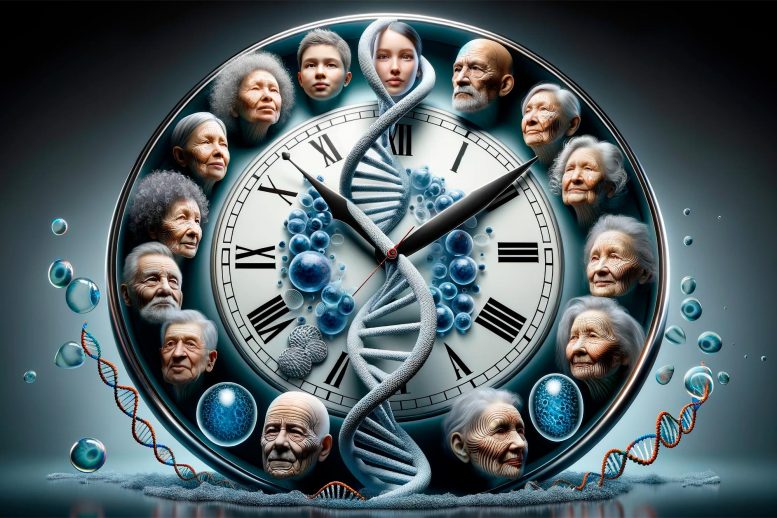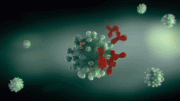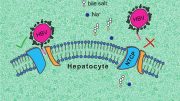
Scientists are researching how genetic mutations in every cell of the human body contribute to aging and the risk of related diseases like cancer. Using advanced sequencing technologies, their study aims to determine if the rate of mutations varies among individuals and how these variations might predict lifespan and disease risk. Their work is part of a larger effort to understand genetic changes across the human lifespan. Credit: SciTechDaily.com
Why do people age differently? With $3.5M National Institutes of Health grant, research teams from Case Western Reserve University / University Hospitals Cleveland Medical Center and NYU Grossman School of Medicine / NYU Langone Hospital hope to find out.
Throughout our lives, changes in our DNA, called genetic mutations, occur in every healthy cell of the human body—mutations that have long been thought to be an important reason why our bodies age.
But it’s not known whether some people accumulate mutations at a faster or slower rate with age, and whether those differences might predict how long we live and the risk for aging-related diseases like cancer.
With a $3.5 million research project grant from the National Institutes of Health (NIH), Jonathan Shoag, a surgeon-scientist at the Case Western Reserve University School of Medicine and urologic oncologist at University Hospitals Cleveland Medical Center’s Urology Institute, and Gilad Evrony, a physician-scientist at New York University (NYU) Grossman School of Medicine and NYU Langone Hospital, seek to answer these critical questions.
Shoag and Evrony, together with a team of collaborators, will leverage new sequencing technologies in a large number of people to understand how mutations that arise throughout the lifespan may associate with the risk of aging-related diseases like cancer.
“Our study will help us understand healthy aging and define new predictors for aging-related diseases,” Shoag said. “This has the potential to allow us to try to prevent aging-associated diseases sooner with clinical interventions.”
“Much remains unknown about how DNA mutations affect the fundamental process of aging, because only recently have the technologies become available to detect these changes in DNA,” Evrony said. “Studying aging-related mutations on a large scale will reveal how our genome dynamically changes throughout our lives.”
Shoag and Evrony are also part of the NIH Somatic Mosaicism across Human Tissues consortium, a multi-institutional effort designed to develop technologies to understand these mutations across the body.









Amazing, ineligible for any research grant money myself as a lone lay victim/investigator, some forty-two years after I stumbled onto the reason for aging these researchers are getting a $3.5 million grant to study what I’ve been sharing free-of-charge for the past eighteen years, starting with the FDA (with replies) in October of 2005, gradually and intermittently expanded and updated since.
As “…a board-eligible urologist-scientist specializing in the study, diagnosis and surgical treatment of prostate cancer…” Dr. Shoag is almost ideally positioned to confirm my lay findings: high blood serum levels of uric acid and acidic urine resultant of long-term inherited/acquired nearly subclinical non-IgE-mediated food allergy reactions aggravated (or not) with FDA approved food poisoning (e.g., added MSG, minimally). As applied to “…genetics and to help solve diagnostic mysteries in neurology and psychiatry…” Dr. Evrony is well situated to investigate my lay finding that acidic blood/body fluids erode the myelin sheaths of brain and nerve cells to contribute to aging and brain disorders, like dementia (e.g., some fatal family and temporary personal history).
Now eighty years of age and, sadly, too slow a lay learner to save most of them, I’m now the longest lived of my immediate family. And, for at least a while in 2024, I’m still available for consultation, free-of-charge. It’s the ‘lucid’ thing to do.
References?
Thanks for the inquiry, Paul. Subjectively, I aged about twenty years and mostly recovered from it between early 1980 and late 1981. Due to the unavailability of research grant money after I was already ill and suffering financially, with my doctors still ignorant of my kind of food allergies and FDA approved food poisoning, I discovered the uric acid/calcium connection online following at-home dietary experiments throughout most of 2010. With a family history of dementia and chronic high blood serum levels of uric acid I only ‘postulate’ the erosion of the myelin sheaths. As to real documented sources, try the “About” page of my video channel: https://odysee.com/@charlesgshaver:d?view=about